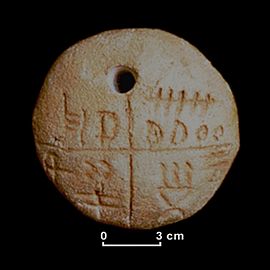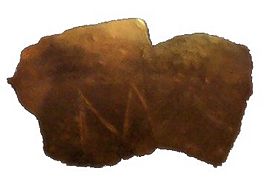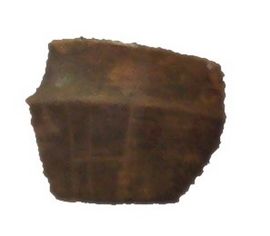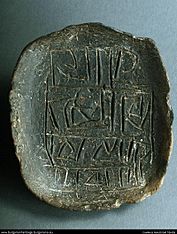Vinča symbols facts for kids
The Vinča symbols are a collection of mysterious marks found on ancient objects. People also call them the Danube script or Vinča signs. These symbols were discovered on artifacts from the Stone Age in cultures like the Vinča culture in Central Europe and Southeastern Europe. Scientists are still debating if these symbols are one of the earliest forms of writing or just simple marks. Some call them "pre-writing" or "proto-writing" because they might be a step towards real writing. These symbols stopped being used around 3500 BC.
Contents
Discovering the Ancient Symbols
In 1875, an archaeologist named Baroness Zsófia Torma led digs in a place called Tordos, which is now Turdaș, Romania. She found pieces of pottery and marble with strange, unknown symbols. Along with these, she also found female statues, pots, and stone tools.
Later, in 1908, another archaeologist, Miloje Vasić, found similar items in Vinča, a town near Belgrade, Serbia. Vinča is about 245 kilometers from Turdaș. More fragments were found in Banjica, another part of Belgrade.
Since 1875, over 150 places with Vinča symbols have been found in Serbia alone. Many of these sites, including Vinča itself, have not been fully dug up yet. Because of all these discoveries, the culture of this area is now called the Vinča culture. The symbols are often known as the Vinča–Turdaș script.
The Tărtăria Tablets Mystery
In 1961, a team led by Nicolae Vlassa found the Tărtăria tablets in Romania. This discovery restarted the discussion about the symbols. Vlassa thought these marks were pictograms, which are pictures that represent words or ideas.
Other items found at the Tărtăria site were tested using radiocarbon dating. This test showed they were from before 4000 BC. This date was 1,300 years earlier than Vlassa expected. It meant these symbols were older than the writing systems of the Sumerians and Minoans. However, some people still question how these tablets were found and if they are truly authentic.
Gradeshnitsa Tablets
The Gradeshnitsa tablets are clay objects with marks carved into them. They were found in 1969 near Gradeshnitsa village in Bulgaria. These tablets are from the 4th millennium BC. You can see them today at the History Museum of Vratsa.
What the Symbols Look Like
Many Vinča symbols have been found, but most objects only have a few marks. This means they probably don't form a complete story or message. One possible exception is the Sitovo inscription in Bulgaria, but its age is still debated. Even that inscription only has about 50 symbols.
Most of these symbols are found on pottery. Some are also on ceramic spindle whorls (tools used for spinning thread), figurines (small statues), and a few other items. The symbols themselves are a mix of abstract shapes and simple pictures. Some look like animals (zoomorphic), while others are like combs or brushes. There are also abstract symbols such as swastikas, crosses, and chevrons.
More than 85% of the objects have only one symbol. Other objects have groups of symbols. Sometimes, these groups don't seem to follow any clear pattern, making it hard to know the order or direction of the signs. The way symbols are used changes depending on the object. Single symbols are almost always on pots. Groups of symbols are often found on spindle whorls.
Scientists have studied the symbols using language analysis. They found that 59% of the signs look like pottery marks. About 11.5% are part of decorations often seen on Vinča culture whorls. The remaining 29.5% might be a type of symbolic notation, meaning they represent ideas or concepts.
A special database called DatDas was created by Marco Merlini to organize Vinča inscriptions. It has a catalog of 5,421 actual signs. These signs come from 1,178 inscriptions that have two or more signs, and 971 inscribed objects.
How Old Are They?
These discoveries are very important because most Vinča symbols were made between 4500 and 4000 BC. The symbols on the Tărtăria clay tablets might even be from around 5300 BC, though this is still debated.
This means that the Vinča finds are more than a thousand years older than the proto-Sumerian pictographic script from Uruk (modern Iraq). The Uruk script is usually thought to be the oldest known writing system. Studies of the Vinča symbols show they are very different from Near Eastern writing. This suggests that the Vinča symbols and the Sumerian script probably developed separately.
See also
 In Spanish: Escritura Vinča para niños
In Spanish: Escritura Vinča para niños
- Banpo symbols, symbols found in China, also thought to be proto-writing.
- Dispilio Tablet
- Gradeshnitsa tablets
- Jiahu symbols, even older symbols from China, sometimes called proto-writing.
- Kamyana Mohyla, Ukraine, ancient rock carvings from caves.
- List of inscriptions in Serbia
- Undeciphered writing systems, writing systems that haven't been figured out yet.
- Old European cultures, ancient cultures in Europe.
- Prehistoric Romania, the history of Romania before written records.
- Prehistoric Serbia, ancient places in Serbia.
- Sitovo inscription






